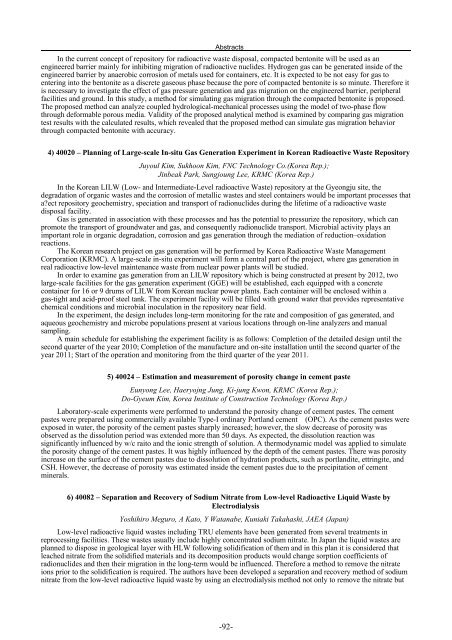ASME Message
ASME Message
ASME Message
You also want an ePaper? Increase the reach of your titles
YUMPU automatically turns print PDFs into web optimized ePapers that Google loves.
Abstracts<br />
In the current concept of repository for radioactive waste disposal, compacted bentonite will be used as an<br />
engineered barrier mainly for inhibiting migration of radioactive nuclides. Hydrogen gas can be generated inside of the<br />
engineered barrier by anaerobic corrosion of metals used for containers, etc. It is expected to be not easy for gas to<br />
entering into the bentonite as a discrete gaseous phase because the pore of compacted bentonite is so minute. Therefore it<br />
is necessary to investigate the effect of gas pressure generation and gas migration on the engineered barrier, peripheral<br />
facilities and ground. In this study, a method for simulating gas migration through the compacted bentonite is proposed.<br />
The proposed method can analyze coupled hydrological-mechanical processes using the model of two-phase flow<br />
through deformable porous media. Validity of the proposed analytical method is examined by comparing gas migration<br />
test results with the calculated results, which revealed that the proposed method can simulate gas migration behavior<br />
through compacted bentonite with accuracy.<br />
4) 40020 – Planning of Large-scale In-situ Gas Generation Experiment in Korean Radioactive Waste Repository<br />
Juyoul Kim, Sukhoon Kim, FNC Technology Co.(Korea Rep.);<br />
Jinbeak Park, Sungjoung Lee, KRMC (Korea Rep.)<br />
In the Korean LILW (Low- and Intermediate-Level radioactive Waste) repository at the Gyeongju site, the<br />
degradation of organic wastes and the corrosion of metallic wastes and steel containers would be important processes that<br />
a?ect repository geochemistry, speciation and transport of radionuclides during the lifetime of a radioactive waste<br />
disposal facility.<br />
Gas is generated in association with these processes and has the potential to pressurize the repository, which can<br />
promote the transport of groundwater and gas, and consequently radionuclide transport. Microbial activity plays an<br />
important role in organic degradation, corrosion and gas generation through the mediation of reduction–oxidation<br />
reactions.<br />
The Korean research project on gas generation will be performed by Korea Radioactive Waste Management<br />
Corporation (KRMC). A large-scale in-situ experiment will form a central part of the project, where gas generation in<br />
real radioactive low-level maintenance waste from nuclear power plants will be studied.<br />
In order to examine gas generation from an LILW repository which is being constructed at present by 2012, two<br />
large-scale facilities for the gas generation experiment (GGE) will be established, each equipped with a concrete<br />
container for 16 or 9 drums of LILW from Korean nuclear power plants. Each container will be enclosed within a<br />
gas-tight and acid-proof steel tank. The experiment facility will be filled with ground water that provides representative<br />
chemical conditions and microbial inoculation in the repository near field.<br />
In the experiment, the design includes long-term monitoring for the rate and composition of gas generated, and<br />
aqueous geochemistry and microbe populations present at various locations through on-line analyzers and manual<br />
sampling.<br />
A main schedule for establishing the experiment facility is as follows: Completion of the detailed design until the<br />
second quarter of the year 2010; Completion of the manufacture and on-site installation until the second quarter of the<br />
year 2011; Start of the operation and monitoring from the third quarter of the year 2011.<br />
5) 40024 – Estimation and measurement of porosity change in cement paste<br />
Eunyong Lee, Haeryojng Jung, Ki-jung Kwon, KRMC (Korea Rep.);<br />
Do-Gyeum Kim, Korea Institute of Construction Technology (Korea Rep.)<br />
Laboratory-scale experiments were performed to understand the porosity change of cement pastes. The cement<br />
pastes were prepared using commercially available Type-I ordinary Portland cement (OPC). As the cement pastes were<br />
exposed in water, the porosity of the cement pastes sharply increased; however, the slow decrease of porosity was<br />
observed as the dissolution period was extended more than 50 days. As expected, the dissolution reaction was<br />
significantly influenced by w/c raito and the ionic strength of solution. A thermodynamic model was applied to simulate<br />
the porosity change of the cement pastes. It was highly influenced by the depth of the cement pastes. There was porosity<br />
increase on the surface of the cement pastes due to dissolution of hydration products, such as portlandite, ettringite, and<br />
CSH. However, the decrease of porosity was estimated inside the cement pastes due to the precipitation of cement<br />
minerals.<br />
6) 40082 – Separation and Recovery of Sodium Nitrate from Low-level Radioactive Liquid Waste by<br />
Electrodialysis<br />
Yoshihiro Meguro, A Kato, Y Watanabe, Kuniaki Takahashi, JAEA (Japan)<br />
Low-level radioactive liquid wastes including TRU elements have been generated from several treatments in<br />
reprocessing facilities. These wastes usually include highly concentrated sodium nitrate. In Japan the liquid wastes are<br />
planned to dispose in geological layer with HLW following solidification of them and in this plan it is considered that<br />
leached nitrate from the solidified materials and its decomposition products would change sorption coefficients of<br />
radionuclides and then their migration in the long-term would be influenced. Therefore a method to remove the nitrate<br />
ions prior to the solidification is required. The authors have been developed a separation and recovery method of sodium<br />
nitrate from the low-level radioactive liquid waste by using an electrodialysis method not only to remove the nitrate but<br />
-92-


